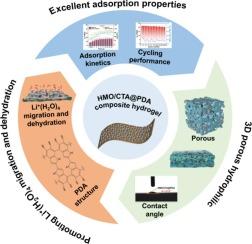Constructing porous hydrophilic HMO/CTA@PDA composite hydrogel for super-high and ultrafast extraction of lithium ions
IF 9.8
1区 工程技术
Q1 ENGINEERING, CHEMICAL
引用次数: 0
Abstract
Adsorption is recognized as an effective and eco-friendly strategy for extracting lithium from salt-lake brine. However, the lithium-ion sieves typically used are in powder form, which poses challenges such as poor fluidity, low permeability, and reduced recovery rates, thereby limiting their industrial utility. This work introduces the development of manganese lithium-ion sieves composite hydrogels (HMO/CTA@PDA), that which demonstrate rapid adsorption rates and enhanced cyclic stability. The HMO/CTA@PDA is synthesized via the nonsolvent-induced phase separation (NIPS) method, utilizing cellulose triacetate (CTA) as the matrix, H1.6Mn1.6O4 (HMO) as the active material, and polydopamine (PDA) as the modification agent. The integration of PDA, rich in polar functional groups, notably improves the interfacial contact within an aqueous medium. This modification reduces the number of water molecules at the HMO/CTA@PDA interface through rapid dehydration, effectively lowering the energy barrier for Li+ migration. Additionally, the three-dimensional porous network of HMO/CTA@PDA facilitates enhanced diffusion channels for Li+, enabling more efficient ion transport. Comparative analyses indicate that HMO/CTA@PDA hydrogels possess significantly higher adsorption rates for Li+, achieving an adsorption capacity of 29.18 mg/g within 4 h, compared to 28.28 mg/g within 36 h for the unmodified HMO/CTA. At the same time HMO/CTA@PDA also exhibits high selectivity (superior Kd value for Li+ compared to other ions in sulfate-rich brines), and outstanding recyclability (stable adsorption capacity of ∼29.58 mg/g over 15 cycles with minimal Mn loss). The HMO/CTA@PDA offers a promising strategy for sustainable Li+ recovery from salt-lake brines.

构建多孔亲水性 HMO/CTA@PDA 复合水凝胶,用于超高速萃取锂离子
吸附法被认为是从盐湖卤水中提取锂的有效且环保的策略。然而,通常使用的锂离子筛是粉末状的,这就带来了流动性差、渗透性低、回收率低等挑战,从而限制了其工业实用性。这项工作介绍了锰锂离子筛分复合水凝胶(HMO/CTA@PDA)的开发情况,这种水凝胶具有快速吸附率和更高的循环稳定性。HMO/CTA@PDA 以三醋酸纤维素(CTA)为基质,H1.6Mn1.6O4(HMO)为活性材料,聚多巴胺(PDA)为改性剂,通过非溶剂诱导相分离(NIPS)方法合成。PDA 富含极性官能团,它的加入明显改善了水介质中的界面接触。这种改性通过快速脱水减少了 HMO/CTA@PDA 界面的水分子数量,从而有效降低了 Li+ 迁移的能量障碍。此外,HMO/CTA@PDA 的三维多孔网络有利于增强 Li+ 的扩散通道,从而提高离子传输效率。对比分析表明,HMO/CTA@PDA 水凝胶对 Li+ 的吸附率明显更高,在 4 小时内吸附容量达到 29.18 mg/g,而未改性 HMO/CTA 在 36 小时内吸附容量仅为 28.28 mg/g。同时,HMO/CTA@PDA 还表现出很高的选择性(在富含硫酸盐的盐水中,对 Li+ 的 Kd 值优于其他离子)和出色的可回收性(在 15 个周期内,吸附容量稳定在 29.58 mg/g 以下,且 Mn 损失极小)。HMO/CTA@PDA 为从盐湖卤水中可持续回收 Li+ 提供了一种前景广阔的策略。
本文章由计算机程序翻译,如有差异,请以英文原文为准。
求助全文
约1分钟内获得全文
求助全文
来源期刊

Desalination
工程技术-工程:化工
CiteScore
14.60
自引率
20.20%
发文量
619
审稿时长
41 days
期刊介绍:
Desalination is a scholarly journal that focuses on the field of desalination materials, processes, and associated technologies. It encompasses a wide range of disciplines and aims to publish exceptional papers in this area.
The journal invites submissions that explicitly revolve around water desalting and its applications to various sources such as seawater, groundwater, and wastewater. It particularly encourages research on diverse desalination methods including thermal, membrane, sorption, and hybrid processes.
By providing a platform for innovative studies, Desalination aims to advance the understanding and development of desalination technologies, promoting sustainable solutions for water scarcity challenges.
 求助内容:
求助内容: 应助结果提醒方式:
应助结果提醒方式:


